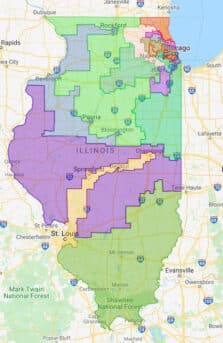Gerrymandering is the practice of redrawing electoral district lines to favor one political party over another, manipulating the democratic process to secure an edge in elections. By carefully crafting district boundaries, politicians can pack voters of the opposing party into a few districts or spread them thinly across many, diluting their influence. It’s a tactic as old as American politics itself, named after Elbridge Gerry, whose 1812 Massachusetts map resembled a salamander. While gerrymandering is often sold as a way to “reflect community interests,” it’s really about rigging the game to ensure one party’s dominance.
Texas Republicans have proposed a mid-decade redistricting plan to flip five Democratic seats, aiming to boost their congressional delegation to 30 of 38 seats, a move that aligns with President Trump’s 56% vote share in Texas in 2024. Democrats, predictably, are crying foul. Some Texas Democrats have even fled to Illinois, of all places, to block the vote by denying a quorum. Illinois, mind you, is one of the most gerrymandered states in the nation, where Democrats have ruthlessly drawn maps to crush Republican representation.
Eric Scmitt (R-MO) wrote on X: “To protest ‘partisan gerrymandering’ Texas Democrats are fleeing to…Illinois. You can’t make this up.”
The irony is thicker than a Chicago deep-dish pizza. If gerrymandering is a sin, Illinois is the cathedral where Democrats have been praying for decades.
Let’s be clear: both Republicans and Democrats are guilty of gerrymandering. But since Texas Republicans have shared their intentions to redistrict the state to better reflect voter share, as seen in the 2024 presidential election, Democrats are acting like this is an act of insurrection they would never dream of doing themselves.

In Illinois, Democrats redrew maps in 2011 to flip the congressional delegation from an 11-8 Republican edge to a 13-5 Democratic advantage by 2012. They doubled down in 2021, crafting a map that gave Democrats a 14-3 edge in 2022, despite Illinois being a competitive state.
Maryland tells a similar story. In 2011, Democrats redrew the state’s maps to turn a 6-2 Democratic edge into a 7-1 advantage, flipping a Republican seat by carving conservative areas into heavily blue districts. These moves cost Republicans at least four seats in Illinois and one in Maryland over the past two decades, showing how Democrats have wielded gerrymandering as a weapon to cement power.
California Governor Gavin Newsom has made his opinion crystal clear regarding Texas, writing on X: “Game on,” and it is time to “fight fire with fire.”
California’s congressional map, while drawn by an “independent” commission, heavily favors Democrats, with 43 of 52 seats in Democratic hands despite competitive statewide races. Urban blue strongholds like Los Angeles and San Francisco dominate the map, diluting conservative voices in rural and suburban areas. Newsom’s threat to redraw California’s map in retaliation, potentially pushing for a 48-4 Democratic edge, exposes the hypocrisy. He’s not upset about gerrymandering; he’s upset Republicans are playing the same game Democrats have mastered.
Governor Kathy Hochul is squawking with the vultures circling Texas’s redistricting plan, yet just last year, she led New York Democrats in a shameless 2024 map grab that flipped four Republican seats, securing 19 of 26 House seats despite Kamala Harris’s 55.9% vote share. Replacing a court-drawn 2022 map that gave Republicans a three-seat gain in the midterms, the Democratic legislature rejected an independent commission’s proposal and crafted a map packing Republican voters into fewer districts. Critics rightly slammed it as blatant gerrymandering, ensuring a Democratic edge in a competitive state.
The message is clear: gerrymandering is only a problem when the other side does it. Democrats have long justified their map-rigging as “correcting imbalances” or “protecting voting rights,” but when Republicans fight fire with fire, it’s suddenly an assault on democracy.
The truth is, gerrymandering is a bipartisan disgrace. Both parties have used it to entrench power, undermine voters, and turn elections into foregone conclusions.
Illinois and Maryland alone cost Republicans at least five seats through aggressive Democratic gerrymandering. Now, as Texas seeks to level the playing field, Democrats are scrambling to paint themselves as victims. If Hochul and Newsom truly cared about fair elections, they’d push for independent redistricting commissions nationwide, not just in blue states like California, but in places like Illinois, where their party has run the table for years. Until then, their outrage is just political theater.
The real scandal isn’t that Republicans are catching up; it’s that the system lets both sides get away with it.
While all facts presented in this article are accurate and supported by credible sources, any opinions or independent views expressed herein are solely those of the author and do not necessarily reflect the views of any affiliated organizations or publishers.





